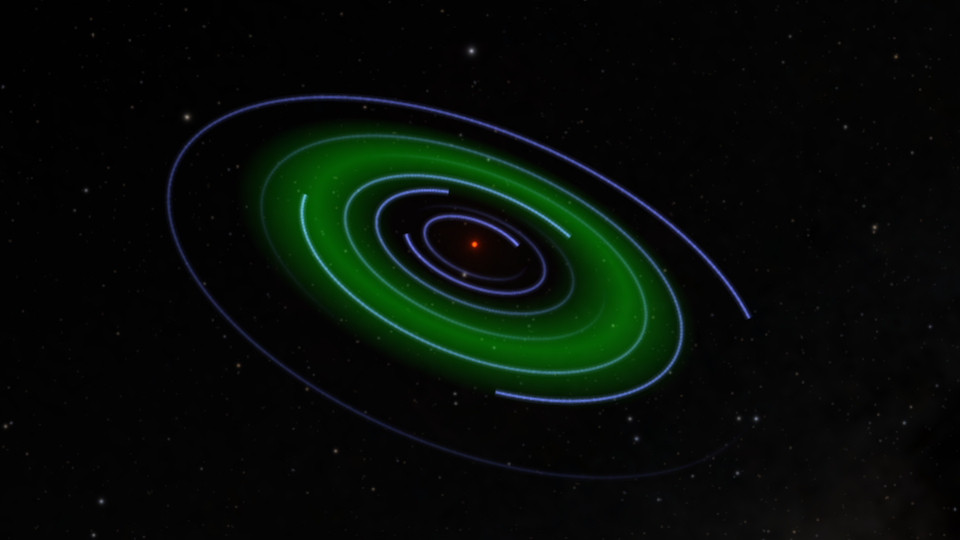Universe Update
Lucky Number Seven
A small, astronomy-focused corner of the Internet has been going crazy the past few days, leading up to today’s announcement about the discovery of (count ’em) seven Earth-ish-sized planets in orbit around a nearby star.
(Every so often, NASA announces a press conference that leads to much excitement and speculation followed by a bit of a let-down when the actual results are announced. The most infamous example is probably the 2010 press conference announcement that claimed “to discuss an astrobiology finding that will impact the search for evidence of extraterrestrial life.” People went a little crazy over that one, requiring more sober members of the community to calm people down. Then the actual press conference dealt with proposed arsenic-based life, which certainly felt less exciting than the wild conjectures floating around beforehand. And to add insult to injury, the result was later disproven. The announcement of today’s press conference didn’t create such a frenzy, but it did lead to elaborate speculation, which turned out to be pretty close to the mark, much to the consternation of NASA press officers.)
So what’s the big deal about today’s announcement? Why is it not a let-down? After all, we know of more than 3,000 exoplanets and counting, and we’ve found plenty of planets roughly the same size as Earth.
But seven planets, each about the size of Earth, all orbiting the same star? That’s a find.
The star in question is TRAPPIST-1, a star so hip it has its own website (although it could use a little CSS assistance). Too faint to be seen from Earth without a telescope (sorry, stargazers), the star made news last year with the announcement of the discovery of three planets in orbit around it. Today’s announcement (from the same research team) reveals that their continued searches uncovered four additional planets—three of which reside in the star’s habitable zone, also nicknamed the Goldilocks Zone, a “just right” region where liquid water could exist on the surface of an Earth-sized world. “In this system, Goldilocks has many sisters,” said Sara Seager of the Massachusetts Institute of Technology.
Astronomers have no definitive evidence for water on any of these planets, but Thomas Zurbuchen, associate administrator of NASA’s Science Mission Directorate, seemed optimistic during today’s press conference: “With the right atmospheric conditions, there could be liquid water on any of these planets.” It will take follow-up observations from many telescopes, including the much-discussed James Webb Space Telescope (JWST), due to launch next year.
These planets all orbit their parent star in quite close orbits, completing one revolution in as little as a day and a half—or for the one farthest out, in a little less than two weeks. Compare that to Earth’s 365-day (yep, year-long) revolution, and you can imagine how tightly packed the planets are around TRAPPIST-1. But because the star is an “ultra-cool dwarf,” merely 0.04 percent as luminous as the Sun, this proximity to the star helps keep the planets warm.
The planets also follow quite orderly orbits, with each planet’s period (in other words, the time it takes to revolve once around the star) in a neat ratio with the others. This suggests that they formed much farther from their parent star, migrating inward to settle into their current orbits, which in turn suggests they could be rich in water and volatile compounds—complex chemistry that’s required for life, but doesn’t always survive the heat of planetary formation.
But those orderly orbits are subject to tiny disruptions, too! All those planets rubbing gravitational elbows with one another means that they influence one another’s paths, introducing slight variations in their periods that provide a powerful tool to astronomers. Measuring the slight changes in timing allows astronomers to calculate the planets’ masses. And because the radii of the planets are known from measuring their transits in front of the star, we can then figure out the planets’ densities—and determine if they are gassy, icy, or rocky. All of the planets seem to fall on the rocky end of the spectrum, although only one is denser than Earth. The slightly lower densities could suggest the presence of lots of volatile compounds (see above why that could be good news), but more work is required to tease out the planets’ attributes.
Although TRAPPIST-1 is named for the telescope (the TRAnsiting Planets and PlanetesImals Small Telescope) that made the initial observations, it required some space-based assistance to pin down these seven planets’ specifics.
TRAPPIST-1 shines thousands of times more brightly in the infrared than in visible light, which makes it an ideal target for NASA’s Spitzer Space Telescope—even though Spitzer was never designed for this kind of work! Sean Carey, manager of NASA’s Spitzer Science Center, even went so far as to describe today’s announcement as “the most exciting discovery we’ve had yet with the Spitzer Space Telescope in its 14-year mission.”
The authors of the current work will continue their search for planets around nearby stars with the SPECULOOS (Search for Planets EClipsing ULtra-cOOl Stars) project, which will search for signs of Earth-sized planets around about a thousand stars! “When there’s one, there’s more,” Seager observed. “There must be many more potentially life-bearing worlds out there, waiting to be found.”
While you’re waiting, you can fuel your imagination with NASA’s latest travel poster, featuring TRAPPIST-1e, a.k.a. “the best ‘hab-zone’ vacation within 12 parsecs of Earth.”
For another perspective on today’s announcement, take a look at this blog entry from one of Morrison Planetarium’s favorite astronomers, Franck Marchis of the SETI Institute. “The discovery of these strange new worlds where life could flourish is the beginning of an exciting time for astronomers and biologists. A time when we are beginning to see the unimaginable, a time when life as we don’t know it can be imaged and studied.”
Images from California Academy of Sciences with planetary textures provided by Caltech







